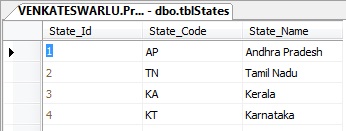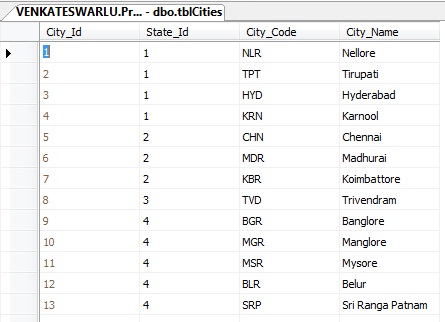Retrieving Dynamic XML from SQL
Server
Introduction
This article will describe the different ways of retrieving XML documents, highlight
my experiences, and list the differences between them.
Three flavors of XML Output
To allow the retrieval of data in the XML format from SQL Server, the FOR XML
command has been added to the T-SQL syntax. Using the FOR XML command with a sequel
query allows the results to be generated as XML.
The command allows three variants
1.
RAW
2.
AUTO
3.
EXPLICIT
If we take the following SQL Query (see Figure 1), which uses the Pubs sample
database shipped with the SQL Server, and apply it to each of the modes (or variants),
we gain an understanding of the various types of XML output that each mode is capable
of producing.


RAW Mode
Query
SELECT
'<rows>'+(
SELECT
S.State_Id,
S.State_Code,
S.State_Name,
C.City_Id,
C.City_Code,
C.City_Name
FROM tblStates S
INNER JOIN
tblCities C
ON C.State_Id
= S.State_Id
FOR XML
RAW
)+'</rows>'
Output
Here is a snippet of the structure generated by the RAW mode.
<rows>
<row State_Id="1" State_Code="AP" State_Name="Andhra
Pradesh" City_Id="1" City_Code="NLR" City_Name="Nellore" />
<row State_Id="1" State_Code="AP" State_Name="Andhra
Pradesh" City_Id="2" City_Code="TPT" City_Name="Tirupati" />
<row State_Id="1" State_Code="AP" State_Name="Andhra
Pradesh" City_Id="3" City_Code="HYD" City_Name="Hyderabad" />
<row State_Id="1" State_Code="AP" State_Name="Andhra
Pradesh" City_Id="4" City_Code="KRN" City_Name="Karnool" />
<row State_Id="2" State_Code="TN" State_Name="Tamil
Nadu" City_Id="5" City_Code="CHN" City_Name="Chennai" />
<row State_Id="2" State_Code="TN" State_Name="Tamil
Nadu" City_Id="6" City_Code="MDR" City_Name="Madhurai" />
<row State_Id="2" State_Code="TN" State_Name="Tamil
Nadu" City_Id="7" City_Code="KBR" City_Name="Koimbattore" />
<row State_Id="3" State_Code="KA" State_Name="Kerala" City_Id="8" City_Code="TVD" City_Name="Trivendram" />
<row State_Id="4" State_Code="KT" State_Name="Karnataka" City_Id="9" City_Code="BGR" City_Name="Banglore" />
<row State_Id="4" State_Code="KT" State_Name="Karnataka" City_Id="10" City_Code="MGR" City_Name="Manglore" />
<row State_Id="4" State_Code="KT" State_Name="Karnataka" City_Id="11" City_Code="MSR" City_Name="Mysore" />
<row State_Id="4" State_Code="KT" State_Name="Karnataka" City_Id="12" City_Code="BLR" City_Name="Belur" />
<row State_Id="4" State_Code="KT" State_Name="Karnataka" City_Id="13" City_Code="SRP" City_Name="Sri
Ranga Patnam" />
</rows>
The XML document produced contains an element <Row>, which is fixed, for each
record of the result set generated by Query. This is not very useful because we
have no control over the element naming and document structure. The RAW mode falls
short of the XML document I am looking to create, and really has limited use.
This query forms all data into attributes format.
Query
SELECT
'<rows>'+(
SELECT
S.State_Id,
S.State_Code,
S.State_Name,
C.City_Id,
C.City_Code,
C.City_Name
FROM tblStates S
INNER JOIN
tblCities C
ON C.State_Id
= S.State_Id
FOR XML RAW ('City'), ELEMENTS
)+'</rows>'
Output
<rows>
<City>
<State_Id>1</State_Id>
<State_Code>AP</State_Code>
<State_Name>Andhra Pradesh</State_Name>
<City_Id>1</City_Id>
<City_Code>NLR</City_Code>
<City_Name>Nellore</City_Name>
</City>
<City>
<State_Id>1</State_Id>
<State_Code>AP</State_Code>
<State_Name>Andhra Pradesh</State_Name>
<City_Id>3</City_Id>
<City_Code>HYD</City_Code>
<City_Name>Hyderabad</City_Name>
</City>
<City>
<State_Id>1</State_Id>
<State_Code>AP</State_Code>
<State_Name>Andhra Pradesh</State_Name>
<City_Id>4</City_Id>
<City_Code>KRN</City_Code>
<City_Name>Karnool</City_Name>
</City>
<City>
<State_Id>2</State_Id>
<State_Code>TN</State_Code>
<State_Name>Tamil Nadu</State_Name>
<City_Id>7</City_Id>
<City_Code>KBR</City_Code>
<City_Name>Koimbattore</City_Name>
</City>
</rows>
The above query generates an xml with nodes for item in data.
AUTO Mode
Query
SELECT
'<rows>'+(
SELECT
[State].State_Id,
[State].State_Code,
[State].State_Name,
[City].City_Id,
[City].City_Code,
[City].City_Name
FROM tblStates [State]
INNER JOIN
tblCities [City]
ON [City].State_Id
= [State].State_Id
FOR XML
AUTO
)+'</rows>'
Output
Below is a cross section of the output structure generated by the AUTO mode.
<rows>
<State State_Id="1" State_Code="AP" State_Name="Andhra
Pradesh">
<City City_Id="1" City_Code="NLR" City_Name="Nellore" />
<City City_Id="2" City_Code="TPT" City_Name="Tirupati" />
<City City_Id="3" City_Code="HYD" City_Name="Hyderabad" />
<City City_Id="4" City_Code="KRN" City_Name="Karnool" />
</State>
<State State_Id="2" State_Code="TN" State_Name="Tamil
Nadu">
<City City_Id="5" City_Code="CHN" City_Name="Chennai" />
<City City_Id="6" City_Code="MDR" City_Name="Madhurai" />
<City City_Id="7" City_Code="KBR" City_Name="Koimbattore" />
</State>
<State State_Id="3" State_Code="KA" State_Name="Kerala">
<City City_Id="8" City_Code="TVD" City_Name="Trivendram" />
</State>
<State State_Id="4" State_Code="KT" State_Name="Karnataka">
<City City_Id="9" City_Code="BGR" City_Name="Banglore" />
<City City_Id="10" City_Code="MGR" City_Name="Manglore" />
<City City_Id="11" City_Code="MSR" City_Name="Mysore" />
<City City_Id="12" City_Code="BLR" City_Name="Belur" />
<City City_Id="13" City_Code="SRP" City_Name="Sri
Ranga Patnam" />
</State>
</rows>
As you can see the <State> and <City>
tags have a parent-child relationship, giving us the hierarchical structure we require.
This node relationship is determined on the order in which the tables are declared
within the query, with each table declared in the sequence becoming a child of the
previously declared table.
Look back at Query and notice the aliases
given within the query affect the names generated within the XML document. Using
this, we can control the labeling of the XML elements and attributes, and achieve
the naming convention we require.
The AUTO mode allows us to create the XML
document we want, but the following disadvantages become apparent with further use:
- We can create hierarchical
structures, but only in a linear fashion, as a parent node can only have one child
and vice versa.
- Using aliases to create element
and attribute names can become tedious and is sometimes counterproductive to the
readability of the query.
- We cannot have both attributes
and elements within the document. Its either all elements, specified using the ELEMENTS
keyword, or the default, which is attributes.
These shortcomings are addressed within
EXPLICIT mode.